A little-known operation of the Manhattan Engineer District took place in Europe. Code-named the “Alsos” Mission, these intelligence-gathering operations moved with the advancing Allies to learn firsthand how close Germany was to developing its own atomic weapon. Under the command of General Leslie Groves, these operations succeeded in capturing most of the key German scientists, stores of uranium ore and other nuclear raw materials, and thousands of research documents regarding the development of atomic energy.
When Groves learned the origins of the code name “Alsos,” he was infuriated: “The Manhattan Project always carefully avoided drawing undue attention to its work and to its people. Code names for our projects were deliberately innocuous. Imagine my horror, then, when I learned that the G-2 had given the scientific intelligence mission to Italy the names “Alsos,” which one of my more scholarly colleagues promptly informed me was the Greek word for “groves.” My first inclination was to have the mission renamed, but I decided that to change it now would only draw attention to it.”
A number of European physicists, including Leo Szilard, Enrico Fermi, and Emilio Segre, were extremely worried about a German effort to build an atomic bomb. After all, uranium had been split for the first time in Nazi Germany in 1938 and German physicists such as Werner Heisenberg and Carl Friedrich von Weizsäcker were regarded as leaders in their field. Many believed that Germany might have as much as a two-year lead in the development of a nuclear weapon. Unless the United States had positive knowledge to the contrary, they assumed that the most competent German scientists and engineers were working on an atomic program with the full capacity of German industry at their disposal.
Gathering Intelligence
 It was critical that United States intelligence officials learn as much as they could about Germany’s progress on an atomic weapon. This objective would prove unusually complex, however, because the cloak of secrecy around the Manhattan Project was so complete that military intelligence could not be told anything about atomic energy and thus would not have the information required to be able to analyze German progress.
It was critical that United States intelligence officials learn as much as they could about Germany’s progress on an atomic weapon. This objective would prove unusually complex, however, because the cloak of secrecy around the Manhattan Project was so complete that military intelligence could not be told anything about atomic energy and thus would not have the information required to be able to analyze German progress.
The solution presented itself in the fall of 1943 when General George Marshall suggested that a separate intelligence operation under the auspices of the Manhattan Engineer District be established. The following excerpt from a memo by General Marshall in late 1943 formalized the plan and established the Alsos Missions:
“While the major portion of the enemy’s secret scientific developments is being conducted in Germany, it is very likely that much valuable information can be obtained thereon by interviewing prominent Italian scientists in Italy….The scope of inquiry should cover all principal scientific military developments and the investigations should be conducted in a manner to gain knowledge of enemy progress without disclosing our interest in any particular field. The personnel who undertake this work must be scientifically qualified in every respect….It is proposed to send at the proper time to allied occupied Italy a small group of civilian scientists assisted by the necessary military personnel to conduct these investigations. Scientific personnel will be selected by Brig. Gen. Leslie R. Groves with the approval of Dr. [Vannevar] Bush and military personnel will be assigned by the Asst. Chief of Staff, G-2, from personnel available to him….This group would form the nucleus for similar activity in other enemy and enemy-occupied countries when circumstances permit.”
The Missions
 The Alsos Missions of the Manhattan Project were conducted in three phases. In addition there was a headquarters mission established in London. The original detachment forming the missions consisted of thirteen military personnel, including interpreters and six scientists. The team members were generally familiar with the research programs of both the United States and Great Britain and were capable of extracting through interrogation and observation detailed scientific information on atomic energy. From the beginning, Alsos was commanded by Lt. Col. Boris T. Pash. Eventually Dr. Samuel Goudsmit came aboard as chief of the scientific component.
The Alsos Missions of the Manhattan Project were conducted in three phases. In addition there was a headquarters mission established in London. The original detachment forming the missions consisted of thirteen military personnel, including interpreters and six scientists. The team members were generally familiar with the research programs of both the United States and Great Britain and were capable of extracting through interrogation and observation detailed scientific information on atomic energy. From the beginning, Alsos was commanded by Lt. Col. Boris T. Pash. Eventually Dr. Samuel Goudsmit came aboard as chief of the scientific component.
In December 1943, a London office was established to act as liaison between the Manhattan Engineer District and various intelligence agencies operating in occupied Europe. The office was first established by Major Robert Furman and later placed under the command of Captain Horace K. Calvert. Maj. Robert Furman returned to Washington to act as General Groves’ personal assistant regarding Alsos mission intelligence. In addition to Calvert, the office was comprised of a Capt. George C. Davis, three WAC’s and two counterintelligence agents. The primary purpose of this liaison office was to pave the road for the three Alsos Missions by locating up to fifty German nuclear scientists and any laboratories that they were suspected of using for atomic research. By the time the second Alsos mission into occupied France was organized, Horace Calvert had succeeded in obtaining dossiers on all of the top German scientists, where they worked and where they lived.
Alsos I: Italy
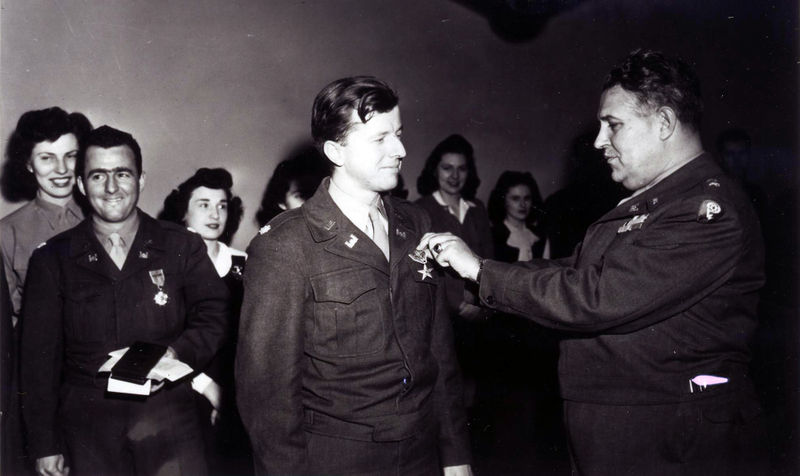 The objectives of the first Alsos mission in Italy was to obtain advance information regarding scientific developments in enemy research and development and to secure all important persons, laboratories, and scientific information immediately upon their becoming available. The Italian Mission was first assembled in Algiers on December 14, 1943. In addition to Lt. Col. Boris Pash, there was an executive officer, four interpreters, four CIC agents and four scientists: Maj. William Allis, Lt. Cdr. Bruce S. Old, Dr. James B. Fisk (OSRD) and Dr. John R. Johnson (also from the OSRD). Maj. Robert Furman and Morris “Moe” Berg were also included in this mission.
The objectives of the first Alsos mission in Italy was to obtain advance information regarding scientific developments in enemy research and development and to secure all important persons, laboratories, and scientific information immediately upon their becoming available. The Italian Mission was first assembled in Algiers on December 14, 1943. In addition to Lt. Col. Boris Pash, there was an executive officer, four interpreters, four CIC agents and four scientists: Maj. William Allis, Lt. Cdr. Bruce S. Old, Dr. James B. Fisk (OSRD) and Dr. John R. Johnson (also from the OSRD). Maj. Robert Furman and Morris “Moe” Berg were also included in this mission.
Intelligence officials were able to make contact with two Italian scientists, Edoardo Amaldi and Gian Carlo Wick. Both scientists admitted that they had not done any atomic research for the Germans or anyone else, and suspected that even if the Germans were working on an atomic bomb it would have taken them at least a decade to complete it. Though the mission was unable to obtain any conclusive information about Germany’s experimentation with atomic energy, several other scientific-type discoveries were of significant use to the Allies.
Alsos II: France
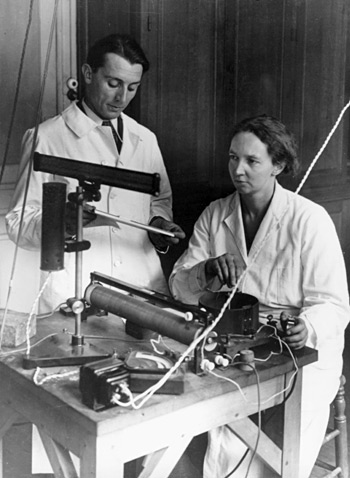 By the summer of 1944, the Alsos contingents had grown to seven operations officers and thirty-three scientists, most of whom were commissioned officers. On August 9, 1944, advance elements of the Alsos mission landed in occupied France and entered the city of Rennes. Later in the month, Col. Pash, Captain Calvert and two other counterintelligence agents joined the leading units of the Twelfth Army as it advanced toward Paris. In fact, Pash’s Jeep was the second vehicle to enter Paris.
By the summer of 1944, the Alsos contingents had grown to seven operations officers and thirty-three scientists, most of whom were commissioned officers. On August 9, 1944, advance elements of the Alsos mission landed in occupied France and entered the city of Rennes. Later in the month, Col. Pash, Captain Calvert and two other counterintelligence agents joined the leading units of the Twelfth Army as it advanced toward Paris. In fact, Pash’s Jeep was the second vehicle to enter Paris.
One of the primary objectives of the Alsos II mission was the College of France in Paris where Frederic Joliot-Curie had his laboratory. Although Joliot willingly assisted his interrogators, many felt that he couldn’t be trusted entirely. However, Juliot did confirm that it was his belief that the Germans had “made little progress” toward harnessing atomic energy. Perhaps the most important information to come out of the Joliot interviews were the names of several important German scientists who had either visited or temporarily worked at Joliot’s laboratory. Those mentioned were Professor Erich Schumann, who once headed German research on uranium; Dr. Kurt Diebner, a nuclear physicist; Professor Walter Bothe, an outstanding German nuclear experimentalist; Dr. Abraham Essau, Dr. Wolfgang Gertner, Dr. Erich Bagge, and Dr. Werner Maurer.
By early fall, Paris was firmly in the hands of the Allies and the Alsos II mission established a headquarters there. From this headquarters several smaller Alsos teams worked with the advancing armies to begin the awesome task of searching for the German scientists, capturing any nuclear related materials such as uranium and heavy water, and locating and deciphering any related scientific documents. The most difficult task would be locating the German scientists and their laboratories, although Calvert’s “road map” from the London office helped immensely.
During the latter months of 1944, the Alsos mission advanced toward Germany. However, progress was temporarily halted by the German counter-offensive (Battle of the Bulge) during the late fall and winter of 1944. As a result, Alsos officials used this time to analyze the thousands of pieces of information that had come into their possession. Persistent references to a small German community of Hechingen gave rise to the belief that some type of nuclear research might be centered there. However, the whereabouts of three of the most prominent of the German physicists, Werner Karl Heisenberg, Otto Hahn and Carl von Weizacker, were still unknown.
Alsos III: Germany
The Alsos III mission entered Germany on February 24, 1945. By this time, an additional urgency now occupied much of their time: none of Germany’s nuclear materials and absolutely none of the German scientists must be allowed to fall into Soviet hands. This new objective became crucial as the Allies advanced toward Berlin. For instance, one key German facility lay square within the planned Soviet zone. There was no way that the American troops could reach the facility first so General Groves made a request to General Marshall to have it destroyed. On March 15th, 612 Flying Fortresses of the 8th Air Force dropped close to 2,000 tons of high explosives on the Auergesellschaft Works in Oranienburg just to the north of Berlin. The plant, and all of its contents, were totally destroyed.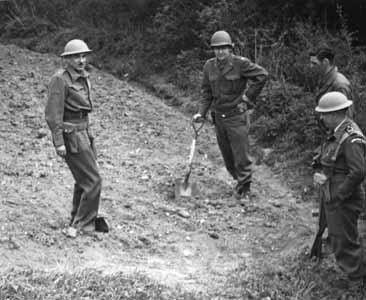
Further intrigue ensued with a little known tactical Alsos mission labeled Operation Harborage. After France fell to the Allies, it was decided to give the French a “zone of occupation” in Germany when the Nazis finally surrendered. The zone given to the French was originally designated as an American zone. Several suspected nuclear research facilities, including the research center reputed to be in the Hechingen area, were in the planned French zone. Once again, General Groves intervened to ensure that any nuclear research documents or raw material would be secured by the United States. According to Groves, “there could be no question but that American troops must be the first to arrive at this vital installation, for it was of the utmost importance to the United States that we control the entire area that contained the German atomic energy activities…I was forced to initiate some drastic measures to accomplish our purpose.”
The strategy behind Operation Harborage was to have a sizable force cut diagonally across in front of the advancing French army and seize the area long enough to capture any German scientists, seize and remove all available records, and destroy any remaining facilities. The operation was initiated in April 1945 and Hechingen was captured on April 24th. Col. Pash seized a large atomic physics laboratory and took into custody several sought-after scientists including Otto Hahn, Carl von Weizacker, and Max von Laue. It was learned that Heisenberg, Walther Gerlach, and a few others had left Hechingen two weeks prior and were possibly in Munich or at Urfeld in the Bavarian Alps. On the 27th, the German scientists were transferred to Heidelberg for further questioning, where information on the whereabouts of German atomic research records were revealed by von Weizacker. They were sealed in a metal drum which was stored in a cesspool in back of von Weizacker’s house.
While Operation Harbo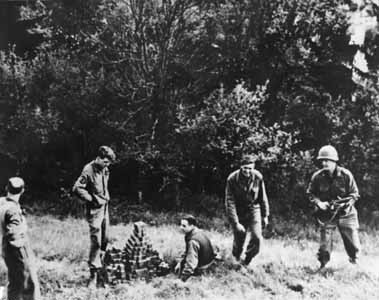 rage was under way, continuing investigations at the Alsos Forward Headquarters at Heidelberg made significant progress. It became apparent that there were two groups in Germany working on the uranium pile, the first under Kurt Diebner at Frankfurt and the second under Werner Heisenberg. On April 12th, Diebner’s laboratory was seized in Frankfurt. On May 1, 1945, Gerlach was captured and Diebner was picked up on the 3rd. Simultaneously, an operation led by Pash at Urfeld resulted in the capture of Heisenberg, who was quickly removed along with confiscated records to Heidelberg.
rage was under way, continuing investigations at the Alsos Forward Headquarters at Heidelberg made significant progress. It became apparent that there were two groups in Germany working on the uranium pile, the first under Kurt Diebner at Frankfurt and the second under Werner Heisenberg. On April 12th, Diebner’s laboratory was seized in Frankfurt. On May 1, 1945, Gerlach was captured and Diebner was picked up on the 3rd. Simultaneously, an operation led by Pash at Urfeld resulted in the capture of Heisenberg, who was quickly removed along with confiscated records to Heidelberg.
One other major accomplishment of Alsos III was an operation headed up by John Lansdale into an area near Stassfurt, Germany. After seizing a salt mine known as the WIFO plant, Lansdale and his men discovered an inventory of close to 1100 tons of uranium ore. This discovery prompted the following memo from General Groves, head of the Manhattan Engineer District, to General George Marshall, Chief of Staff: “In 1940 the German army in Belgium confiscated and removed to Germany about 1200 tons of uranium ore. So long as this material remained hidden under the control of the enemy, we could not be sure but that he might be preparing to use atomic weapons. Yesterday I was notified by cable that personnel of my office had located this material near Stassfurt, Germany, and that it was now being removed to a safe place outside Germany where it would be under the complete control of American and British authorities. The capture of this material, which was the bulk of uranium supplies available in Europe, would seem to remove definitely any possibility of the Germans making any use of an atomic bomb in this war.”
Operation Epsilon
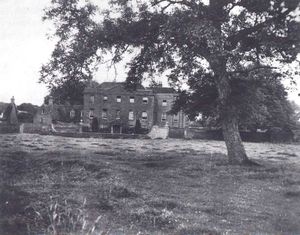 Operation Epsilon was the code name of a program in which Allied forces near the end of World War II detained ten German scientists, including Werner Karl Heisenberg, Kurt Diebner, Otto Hahn, Carl von Weizacker, and Max von Laue, who were thought to have worked on Nazi Germany’s nuclear program. The scientists were captured between early May and late June, 1945, and interned at Farm Hall, a bugged house in Godmanchester, England, from July 3, 1945 to January 3, 1946. The objective of the program was to determine how close Nazi Germany had been to constructing an atomic bomb by surreptitiously recording their conversations. When the scientists learned that an atomic bomb had been dropped on Hiroshima, they expressed surprise and shock that the Americans were able to develop the weapon in such a short amount of time. In the transcripts, several scientists, including Otto Hahn, express relief that Germany did not develop such a weapon for Hitler while others question whether they miscalculated the amount of fissionable material needed for an atomic weapon of significant proportion. One interesting dialogue follows:
Operation Epsilon was the code name of a program in which Allied forces near the end of World War II detained ten German scientists, including Werner Karl Heisenberg, Kurt Diebner, Otto Hahn, Carl von Weizacker, and Max von Laue, who were thought to have worked on Nazi Germany’s nuclear program. The scientists were captured between early May and late June, 1945, and interned at Farm Hall, a bugged house in Godmanchester, England, from July 3, 1945 to January 3, 1946. The objective of the program was to determine how close Nazi Germany had been to constructing an atomic bomb by surreptitiously recording their conversations. When the scientists learned that an atomic bomb had been dropped on Hiroshima, they expressed surprise and shock that the Americans were able to develop the weapon in such a short amount of time. In the transcripts, several scientists, including Otto Hahn, express relief that Germany did not develop such a weapon for Hitler while others question whether they miscalculated the amount of fissionable material needed for an atomic weapon of significant proportion. One interesting dialogue follows:
Diebner: “I wonder whether there are microphones installed here?”
Heisenberg: “Microphones installed? (Laughter) Oh, no, they’re not as cute as all that. I don’t think they know the real Gestapo methods; they’re a bit old-fashioned in that respect.”
The three Alsos missions into occupied Europe were a little known yet eminently successful operation of the Manhattan Engineer District. At the end of the war in Europe there were 114 men and women with Alsos comprised of twenty-eight officers, forty-three enlisted men, nineteen scientists, five civilian employees and nineteen CIC agents. The mission was officially disbanded on October 15, 1945.
Why did Germany Fail to Build an Atomic Bomb?
 Much debate exists today surrounding the Germans failed attempt to build an atomic bomb. Germany was not only the birthplace of modern physics, it also produced some the leading nuclear physicists of the time and possessed the raw materials and industrial base needed to develop an atomic bomb. Some, including Heisenberg himself, argued that the Germans did not develop the bomb for moral reasons; that is, Heisenberg and his colleagues consciously obstructed the development of the bomb to prevent Hitler from ever having such a weapon at his disposal.
Much debate exists today surrounding the Germans failed attempt to build an atomic bomb. Germany was not only the birthplace of modern physics, it also produced some the leading nuclear physicists of the time and possessed the raw materials and industrial base needed to develop an atomic bomb. Some, including Heisenberg himself, argued that the Germans did not develop the bomb for moral reasons; that is, Heisenberg and his colleagues consciously obstructed the development of the bomb to prevent Hitler from ever having such a weapon at his disposal.
Others, such as Leslie Groves, have argued that the Germans did not develop the atomic bomb because they had severely miscalculated the amount of fissionable material required for an atomic device and that they simply did not understand the technical science behind the development of such a weapon. Still others have made the case that the German atomic program to develop a bomb was farther along than most historians have believed and some have alleged that Diebner’s team conducted the first successful nuclear weapon test of some type (employing hollow charges for ignition) of nuclear-related device in Ohrdruf, Thuringia on 4 March 1945. The recent discovery of over 126,000 barrels of nuclear waste buried over 2000 feet in an abandoned salt mine near Hanover, Germany in 2011 has created further controversy surrounding the extent of the German atomic bomb program.





